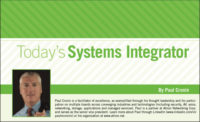AN AGE-OLD SAYING STATES that there are two certainties in life — death and taxes. The reality is that whether you are a security integration company, a product manufacturer or a security service provider, there are many additional work occurrences that are equally as certain. One of these certainties is workplace conflict. One definition of conflict, found in Wikipedia, seems relevant to this discussion. Workplace conflict is defined as, “A state of discord caused by the actual or perceived opposition of needs, values and interests between people working together.”
Here are a few common examples of workplace conflict and three potential principles for resolving disputes.
-
WORK-AT-HOME CONFLICT
COVID-19 and the mass movement of employees to work and live at home created a brand new set of workplace conflicts. Balancing work, children, multi-generational homes, schools, cancelled public activities, sports, spouse schedules, private space and time — the list is endless. While some of these conflicts existed beforehand, the pandemic magnified work conflicts. -
INTERDEPENDENCE CONFLICT
This type of conflict happens when a person relies on someone else in the organization for their success. Let’s say that several coworkers are assigned a project with a tight deadline. Employee A is organized and efficient and wants to schedule team time in regular intervals, so they hit the deadline. Employee B is a procrastinator and waits until the last minute to complete their project assignment. Employee C seems very unconcerned about the project and wastes meeting time talking about completely unrelated things. There is significant potential conflict in this scenario. -
LACK OF SENSITIVITY TO RACE, GENDER, AGE, POLITICS, ETC.
Conflicts can arise between people because of their differences. Rather than negatively focusing on our differences, or being indifferent to them, we should be rejoicing in the fact that people are diverse and multi-faceted. We all have different likes and dislikes and we each can bring unique perspectives to problem-solving and project completion. Seizing on that dynamic can resolve so much. -
DIFFERENCES IN LEADERSHIP STYLE
Managers, business leaders and employees can all have different ways of leading teams and projects. Many employees also answer to multiple people — each with a different style of leadership. Your employees can easily experience conflict just dealing with multiple department heads as well as their own competing priorities. Good leaders will assemble successful teams by recognizing the strengths of each of these styles. -
PERSONALITY CLASHES
Some team members and even leaders tend to manage through emotion while others can be glib and reluctant to show emotion on any topic. This can easily lead to perceptions that are incorrect — but perception is reality. It is critical for business and project leaders to be self-aware and to realize that the emotion, passion and engagement they bring (or don’t bring) to a workplace, work team or project team can have significant consequences.
There are thousands of thought-provoking books and articles on how leaders can resolve workplace conflict. I ascribe to three basic principles when it comes to conflict resolution.
-
DEVELOP A SET OF GUIDING PRINCIPLES FOR YOUR COMPANY.
Set the tone early and often to all employees that your company has core beliefs on how customers and employees are to be treated. Never waver from those principles. -
COMMUNICATION IS KEY.
Conflict is resolved by communicating conflicting motives and engaging in negotiations for a resolution. Gather the facts and get to the root cause of the conflict. This could be done with a “5 Why Exercise”. This Six Sigma practice can help to find the underlying reason for the conflict by simply asking the question “why” five times to get to the heart of the matter. Once the problem is identified, work with the team to establish a solution. -
ABOVE ALL ELSE, BE TRUSTWORTHY AS A LEADER.
Your employees and co-workers must have trust in you if you hope to resolve workplace conflict. Additionally, always be empathetic. This cannot be overstated. Always try to understand what someone is experiencing or feeling that is adding to a conflict.
Conflict in the workplace is inevitable, but not fatal. Control the narrative by establishing basic principles for resolution. Ask yourself and your team how each scenario can help improve future behaviors and processes within your company.






